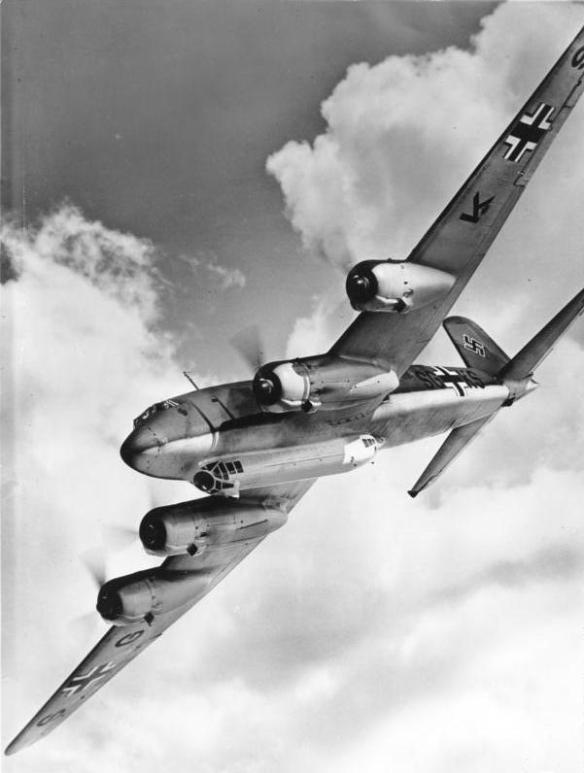Fw 200, “SG+KS” of I.Gruppe/KG 40.
The Fw 200 Condor frequently operated in close cooperation with roving packs of U-boats. These machines had been refitted with a long ventral gondola beneath the fuselage, where bombs were housed. Having identified an enemy convoy, Condors would attack and cripple merchant vessels, leaving the submarines to finish them off. Within a year Fw 200s accounted for several thousand tons of Allied shipping and were justly feared as the “scourge of the Atlantic.” Eventually, the development of long-range fighters like the Bristol Beaufighter and ship-launched disposable Hawker Hurricanes spelled the end of its maritime roles. The Fw 200s next pioneered antishipping missiles, but success proved elusive, and by 1944 most had been reconverted back into transports.
Each side employed float planes in the Battle of the Atlantic. The RAF’s “Sunderland” could reach Iceland and the Bay of Biscay from U.K. bases. It was countered by a Luftwaffe fleet of reconnaissance squadrons equipped with Bv138s and Bv222s, Do-18s, and He-115s. These spotted for an original force of 18 squadrons of He-111 medium bombers, trained before the war to bomb ships and lay mines. Longer-range German aircraft came on stream as the battle developed, notably the Fw200 or Kondor. Continuing interservice arguments between the Kriegsmarine and Luftwaffe, which Hitler characteristically declined to resolve, were especially marked by petulant obstruction of cooperation by Göring. That permitted the Kriegsmarine too few of the right planes to properly scout for the U-boat fleet. Other interservice arguments concerned whether to develop an aircraft-delivered torpedo or specialized antiship bomb. The Luftwaffe ignored all Kriegsmarine design advice on the way to developing an ineffective ship bomb on its own. In the meantime, improving air cover and fighter interception of Kondors by fighters launched from escort carriers pushed back the German air threat to Allied shipping.
Kampfgeschwader 40 (40th Bomber Wing) on the Atlantic Coast of France demonstrated particular proficiency in attacks on shipping. The latter unit employed, among other types, the Focke-Wulf Fw 200 Condor, a long-range reconnaissance bomber famously called the “scourge of the Atlantic” by Winston Churchill for its deadly efficiency between 1940 and 1942.
Condor Aircraft based on a feasibility study ordered in 1936 by Lufthansa for a plane capable of crossing the Atlantic; first flew on 27 July 1937. Designed to carry 26 passengers and four crew-members, this cantilevered low-wing four-engine plane first proved its capacity on a series of long-distance flights for publicity. The longest was a 48-hour flight from Berlin to Tokyo. (The plane crash-landed in Manila Bay on the return leg due to pilot error.) The aircraft was used mostly on European medium-range routes. Sixteen civilian Condors were completed by September 1939, and several more were under construction.
Meanwhile, the Luftwaffe was having trouble defining its long-range aircraft needs. The Junkers Ju 89 and Dornier Do 19 aircraft were canceled, and the Heinkel He 177 project was delayed. By October 1939, 12 civilian Condors (six of which were initially scheduled for delivery to Japan) had been taken over by the Luftwaffe for training in long-range sea reconnaissance. Focke-Wulf received an order for the development of a military version, the Fw 200C series, of which 243 were produced until the closing of production in 1943. The C-4, which was built in the largest numbers, sported additional machine guns and a bomb/torpedo bay. Its primary mission in the Luftwaffe became long-range reconnaissance and the spotting of Allied convoys in the Atlantic. Positions were then relayed to submarines and an attack coordinated.
